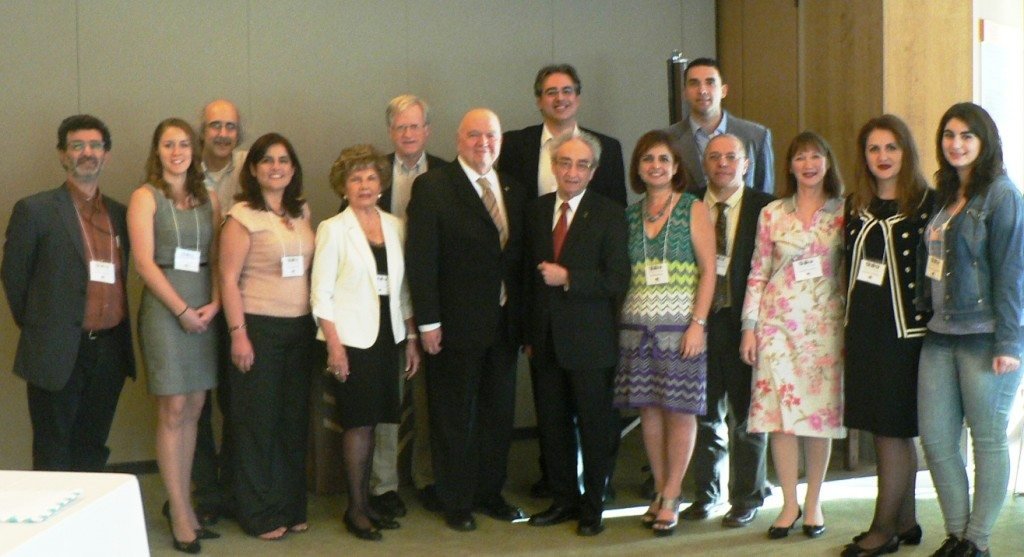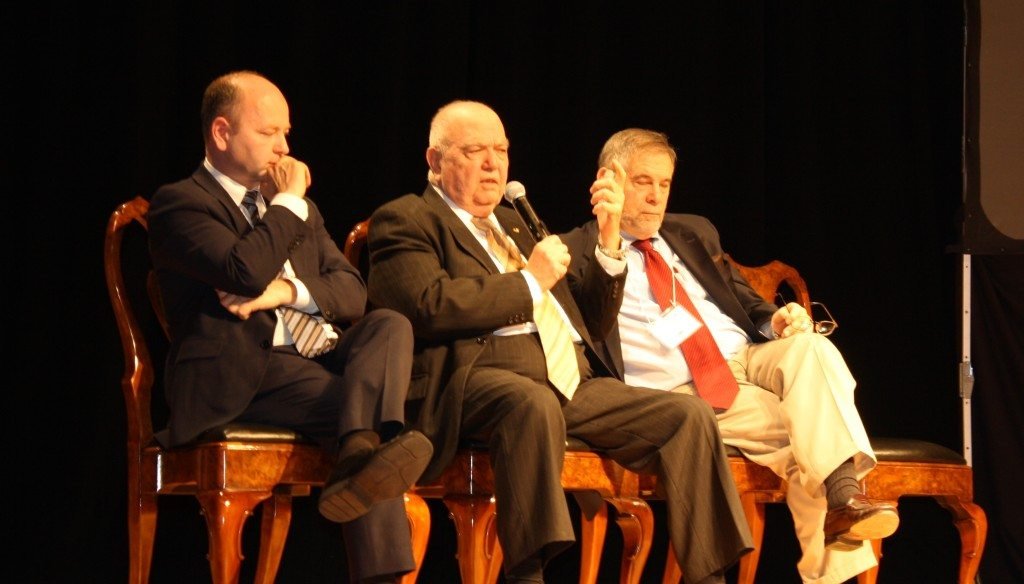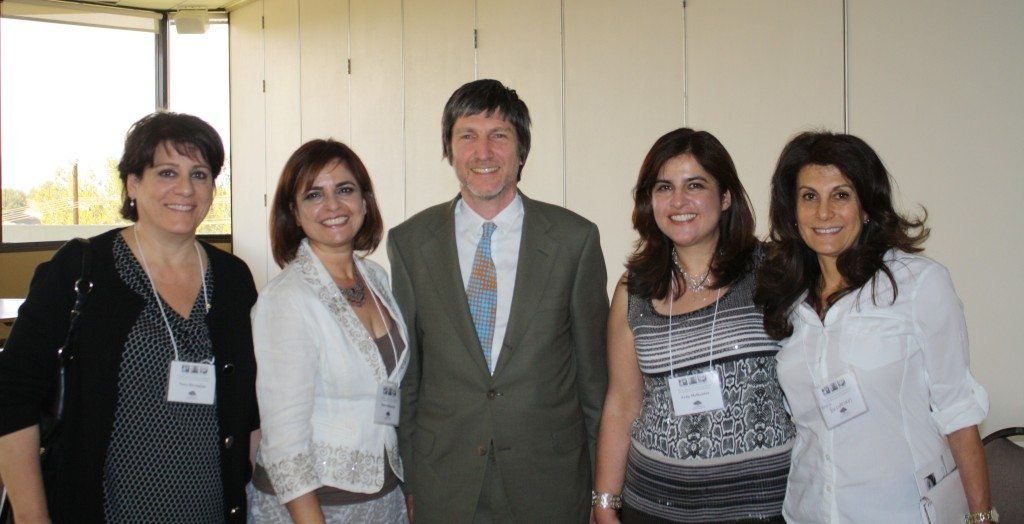By Doris Melkonian and Arda Melkonian
On the eve of the Armenian Genocide Centennial, the 44th Annual Scholars’ Conference (ASC) on the Holocaust and the Churches featured the first Genocide of the 20th century, adopting the theme, Remembering for the Future: Armenia, Auschwitz and Beyond. Rev. Dr. Henry Knight (Professor, Keene State University), President of the Annual Scholars’ Conference commented, “Our theme for this year’s ASC invited us to examine the Genocide of the Armenian people while continuing to sustain our four decades of examining questions and issues raised by the Holocaust. By having more than an occasional session devoted to their distinctive traumas, each of the communities represented at this year’s gathering grew in their grasp of the issues uniquely at stake in their respective histories.”

The historic event, hosted by the American Jewish University, Los Angeles, on March 8-11, 2014, brought together scholars of the Armenian Genocide and Jewish Holocaust in an interdisciplinary, international, interfaith and intergenerational conference. It provided a unique forum for scholars to highlight the events of the Genocide and Holocaust, and to discuss the implications of these tragedies, the impact on subsequent generations, and the necessity of genocide and holocaust education and prevention.
Dr. Marcia Sachs Littell (Professor, Stockton College), Vice-President of the Annual Scholars’ Conference, and wife of the late Rev. Dr. Franklin Littell (Co-founder of the Conference), emphasized the historical significance of the Armenian Genocide in relation to the Holocaust. “The Armenian Genocide, the first Genocide of the Twentieth Century, sent a message to Adolf Hitler, that he could do anything he wanted and the world would not protest.”
The opening plenary session, “A Century of Genocide: What Have We Learned?” allowed for a conversation among clergy and scholars from diverse backgrounds. The panelists, representing different denominations and ethnic groups, Father Dr. John Pawlikowski (Professor, Catholic Theological Union), Dr. Richard Hovannisian (Professor Emeritus, UCLA), Rev. Dr. Henry Knight, and Rabbi Dr. Michael Berenbaum (Professor, American Jewish University) provided unique perspectives to the question posed. Dr. Pawlikowski explained that while a new sensitivity to and awareness of many issues within the Christian community has developed, there has yet to be a movement from awareness to genocide prevention. Dr. Hovannisian shared that increased knowledge and awareness has not led to prevention since governments have not found it in their self-perceived national interest to implement punishment for genocide. Dr. Knight added that the world has become complex and the tools for detecting signals of genocide have also become complex. He underscored the need to spot genocide signposts early in order to effectively prevent killings. Dr. Berenbaum explained that governmental inaction to prevent genocide is not related to matters of conscience but to a lack of political will.
Several papers, presented by Armenian and non-Armenian scholars, focused on the Armenian Genocide, addressing topics such as religion, literature, trauma, altruism, denial, reconciliation, and risk analysis. Armenian scholars from Armenia, Germany, Italy, and various US universities and centers participated in the conference: Ishkhan Chiftjian (Leipzig University & Hamburg University), Richard Dekmejian (Professor, USC), Khachatur Gasparyan (Professor, Yerevan State Medical University), Sona Haroutyunian (Professor, Ca’ Foscari University of Venice), Marc Mamigonian (Academic Affairs Director, National Association for Armenian Studies and Research), Arda Melkonian (Graduate Student, UCLA), Doris Melkonian (Graduate Student, UCLA), Garabet Moumdjian (UCLA), Rubina Peroomian (UCLA), and Vahram Shemmassian (Professor, CSUN).

The religious dimension of the Armenian Genocide was addressed by Ishkhan Chiftjian, Arda Melkonian, and Doris Melkonian. Chiftjian’s paper, “A Theological Approach to the Armenian Genocide,” asserted that survivors experienced faith as one of the reasons and the instruments of the crime. He discussed several examples of religious repression of Armenians; plundering and desecration of churches, monasteries and holy objects; and brutal attacks on clergymen. As victims experienced the Genocide, their faith was challenged, leading them to formulate their own responses to the question of theodicy. Many invoked the suffering of Christ on the cross, convinced that they suffer with Him and for Him. Their suffering does not call into question the nature of God, but instead leads them on a search for a God who has been absent during the Genocide.
Doris Melkonian, in her presentation, “Crisis Within: Faith and the Armenian Genocide” used survivor testimonies from the UCLA Armenian Oral History Collection to examine responses of Genocide survivors as they attempted to reconcile the catastrophic occurrence with their faith and belief in God. This inward reflection, often involving a re-examination of their faith in God, has resulted in various types of religious responses. For some survivors, this catastrophe led them to question the existence of a loving, omnipotent God. Some lost their faith entirely, rejecting a God who chose to forsake them. While for others, their genocidal experiences drew them closer to God, reinforcing their belief in Him.
On another panel, Arda Melkonian presented on “Armenian Evangelical Clergy Responses to the Genocide.” She explained that the Genocide has radically altered Armenian Christianity, changing Armenians’ understanding of God and their faith in Him. However, Armenian theologians have failed to acknowledge the damage caused by this tragic event and have yet to grapple with the profound religious impact it has had on the faith of the Armenian community. Her paper presented pastoral responses to this tragedy, and underscored the need to develop an Armenian theology that can make sense of the suffering and death of innocent Armenian victims. She explained that Armenian clergy must find a way to respond to those who are alienated from God and are asking, “How is it possible to believe in God after the Genocide?” They must speak about God to those who are struggling to understand His absence during the Genocide.

Presentations by Dr. Vahram Shemmassian and Dr. Sona Haroutyunian examined literature about the Armenian Genocide. Shemmassian presented a paper, “The Musa Dagh Resistance to the Armenian Genocide, Franz Werfel’s novel The Forty Days of Musa Dagh, and Their Impact to the Present” showcasing the heroic resistance of Armenians living on Musa Dagh (Mountain of Moses), and addressing the issue of international press coverage and world readership reaction to the resistance. Shemmassian spoke about the impact of The Forty Days of Musa Dagh on the world, and Turkish reaction to the MGM movie project. He posed the question: “What is the relevance of Musa Dagh today in our collective memory on the 80th anniversary of the novel’s publication (1933-2013)?”
Sona Haroutyunian’s paper, “Translation and Representation of the Armenian Genocide in Literature and Film,” analyzed the limitations of each medium (literature, translation, cinema) and the effect of each on reader and audience experiences. Focusing on renowned Italian-Armenian novelist, Antonia Arslan’s genocide narrative Skylark Farm, she discussed the power of translation as a means of cultural, historical and linguistic interaction.
Dr. Rubina Peroomian, in her paper, “The Symbiotic Relationship between Turks and Armenians: A 100-year-old Obstacle against Healing and Reconciliation,” explained that the relationship between Turks and Armenians has been shaped by governmental policies, societal behaviors and stereotyping of each other, with Turks viewing Armenians as gavours, unbelievers, and “rejects of the sword,” with Armenians viewing Turks as evildoers, perpetrators and deniers of the Armenian Genocide. She concluded that as long as this grim symbiosis between Turks and Armenians exists, artificial interventions and joint events will be ineffective in altering the attitudes of the masses. She added, “Healing and reconciliation, if ever possible after an inflicted catastrophe of that magnitude, are plausible only if Turks face their own history, confront and acknowledge the past.”
In “Academic Denial of the Armenian Genocide in American Scholarship: Denialism as Manufactured Controversy” Marc Mamigonian explained, “Although it is well known that denial of the Armenian Genocide began concurrently with the genocide itself, and for decades Turkey and those who support it have ignored, minimized, or denied the Armenian Genocide, the growing body of critical scholarship and documentation of the Armenian Genocide has rendered traditional strategies of silencing and denial increasingly untenable.” He argued that supporters of the “Turkish position” seek to construct denialism as a legitimate intellectual debate. After presenting several examples of denialist rhetoric (e.g., the link between smoking and cancer, between carbon emissions and climate change, or the evolution vs. intelligent design “controversy”), and specific cases of “academic denial,” emanating from American universities, he discussed the fundamental challenges of denialism and the quest for intellectual legitimacy.
Dr. Richard Dekmejian, in “Utility of Pre-Genocidal Risk Assessment: From the Armenian Genocide and Jewish Holocaust to the Present,” discussed risk assessment of pre-genocidal situations, and the foresight of political thinkers and activists who attempted to prevent the Armenian Genocide and Holocaust. He presented a critical analysis of modern-day Early Warning Systems, explaining their ineffectiveness to prevent genocide in up to 15 Middle Eastern, African and Asian countries.
In the final session of the conference, Dr. Garabet Moumdjian presented “Ottoman Official Resistance to the Armenian Genocide in the Southern Theater of War.” Moumdjian discussed examples of Ottoman officials who refused to obey orders from Constantinople to exterminate Armenians. The altruism demonstrated by officials who defied Talaat Pasha’s orders despite the potential risk to their careers, should be further studied. Moumdjian analyzed the political, social, and military reasons motivating Jemal Pasha and others to rescue Armenian deportees. He suggested that Jemal’s motivation may have stemmed from his ambitions of creating and ruling an Arab state, populated by Armenian survivors who would form its new middle class.
A special guest, Henry B. Morgenthau IV, great grandson of Henry Morgenthau, addressed the gathering as a luncheon keynote speaker. He shared with the attendees his great-grandfather’s legacy as ambassador to Turkey during the Armenian Genocide.
The plenary session on “Survival and Self-Actualization – Managing Memory, Identity an Social Conditions after Genocide has Occurred,” featured Khachatur Gasparyan who spoke about “Psychotraumatic Elements of Armenian Identity: One Hundred Years of Surviving.” During another plenary session, Rabbi Dr. Richard Rubenstein (Former President, University of Bridgeport), spoke about “The Armenian Genocide as Holy War,” and David Patterson (Professor, University of Texas at Dallas) presented “From Hitler to Jihadist Jew Hatred: Influences and Parallels.”
The public lecture, “Armenia, Auschwitz and Beyond” featured Dr. Richard Hovannisian, Dr. Stephen Smith (Executive Director of the USC Shoah Foundation), and Dr. Michael Berenbaum, who provided suggestions for future action. Dr. Berebaum urged the community to transform the memory of tragedy into a warning system to prevent future genocides. Dr. Hovannisian challenged the Armenian community to “find ways and means to universalize their experience and make it part of world history as the Jews have done.” Lastly, Dr. Smith alerted the audience to the dangers of obfuscation, stressing that the appropriate response must be to inform it. The evening concluded with the presentation of the Eternal Flame Award to Dr. Smith in recognition of his efforts to remember the victims of the Holocaust and to build a better future for all humanity.
Dr. Hovannisian remarked, “This conference reinforced my view that the comparative study of genocide is the most useful and effective way of confronting the problem. One can be knowledgeable about various cases of genocide, their antecedents, processes, and aftermath without losing sight of the specific factors at play in each individual case…The conference demonstrated that there is much need for such an approach.”



I am wondering why I was not mentioned in this story. I presented right before Dr. Garabet Moumdjian, on the fallacy that the “annihilation of the Armenians” had been forgotten on the eve of WW II. Basically, the moral of my presentation is that memorials and education are not enough, that a determination to intervene must be fostered. While this occurred a year ago, the lessons remain.